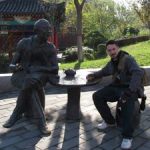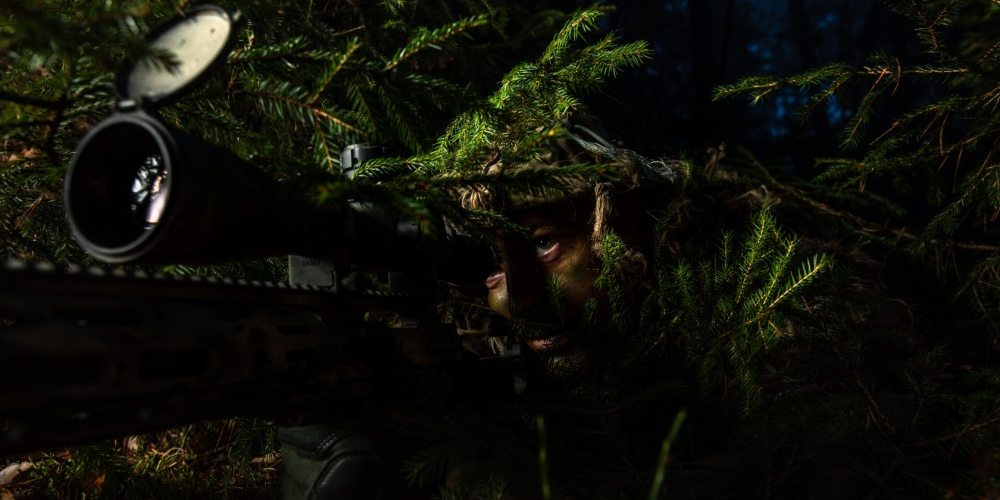- Snipers typically operate at ranges between 600 and 1,200 meters, but it’s possible to take an enemy out from much farther away.
- Every long-range shot consists of countless calculations and considerations to overcome the influence of factors like temperature, weather, wind, and so on to ensure the bullet strikes the intended target.
- “There are a million things that go into being a sniper, and you have to be good at all of them,” a US Army sniper told Business Insider.
Hidden, the sniper peers through his scope. Watching from the shadows, he sets his sights on his target. He thinks through his shot. Holding his breath, he fires. The enemy never sees it coming. Target down.
When you hear the word “sniper,” the image that likely pops into your head is that of a concealed sharpshooter armed with a powerful rifle preparing to fire a kill shot from hundreds of yards away. There’s a good reason for that.
Snipers are defined, at least in part, by their unique ability to eliminate targets at a distance, taking out threats without letting the enemy know that they are coming. It’s a difficult job. Snipers typically operate at ranges between 600 and 1,200 meters, and occasionally take an enemy out from much farther away.
A Canadian special forces sniper, for instance, shattered the world record for longest confirmed kill shot in 2017, shooting an ISIS fighter dead in Iraq from over two miles away.
"There's definitely people out there who have done amazing things," US Army First Sgt. Kevin Sipes, a veteran sniper and instructor at the sniper school at Fort Benning, Georgia, told Business Insider. "Anything is possible."
We asked a handful of elite US Army snipers, each of whom has engaged enemies in combat, what goes into long-range shots. Here is what these expert marksman had to say about shooting like a sniper.
Read More: Here's everything you need to know if you want to join the US Army
"There are a million things that go into being a sniper, and you have to be good at all of them," Sipes told BI.

First, a sharpshooter needs the right gear. A sniper's rifle is his most important piece of equipment, his lifeline. The two standard rifles used by conventional Army snipers are the gas M110 Semi-Automatic Sniper System and the bolt-action M2010 Enhanced Sniper Rifle.
Bullets fired from these rifles leave the barrel at speeds in excess of 750 meters per second, more than two times the speed of sound.
The other critical assets a sniper never wants to go into the field without are his DOPE (Data on Previous Engagements) book and his consolidated data card or range card - hard data gathered in training that allow a sniper to accelerate the challenging shot process. Snipers do not have an unlimited amount of time to make a shot. They have to be able to act quick when called upon.
Second, while every Army sniper has the ability to carry out his mission independently, these sharpshooters typically work closely with their spotters, a critical set of extra eyes on the battlefield.

The two soldiers swap roles in training so that each person is crystal clear on the responsibilities of the other, ensuring greater effectiveness in combat.
Third, a sharpshooter needs a stable firing position, preferably one where the sniper is concealed from the watchful eyes of the enemy and can lie prone, with legs spread to absorb the recoil. Snipers do, however, train to shoot from other positions, such as standing or kneeling.
Read More: America's deadliest sharpshooters reveal how they disappear in plain sight

Fourth, the sniper and his spotter must have a comprehensive understanding of all of the difficult considerations and calculations that go into the shot process, Staff Sgt. Christopher Rance, sniper instructor team sergeant at Fort Benning, explained to BI. The team must measure atmospherics, determine range, determine wind, and then work together to fire accurately on a target.
"The biggest thing you have to consider is, right off the bat, your atmospherics," he said. These include temperature, station pressure, and humidity for starters. "The sniper has to account for all of that, and that is going to help formulate a firing solution."
An important tool is a sniper-spotter team's applied ballistics kestrel, basically a handheld weather station. "It automatically takes readings and calculates a firing solution based on the gun profile we build," Rance told BI.

Next, the pair determines range, which is paramount.
Against lower level threats like militants, snipers can use laser range finders. But trained soldiers likely have the ability to detect that. Against these advanced battlefield enemies, snipers must rely on the reticle in the scope.
"So, basically, we have this ruler, about three and a half, four inches in front of our eyes that's inside the optic that can go ahead and mil off a target and determine a range through that," Rance said.
Once the sniper determines range, the next step is to determine the wind speed. Based on the distance to the target, the sniper must determine wind speed for different zones. "The sniper will then generally apply a hold," Rance explained. "He will dial the elevation on his optic, and he will hold for wind."

When firing from great distances, bullets don't fly straight. Over long range, bullets experience spin drift and gravity's toll, which causes it to slow down from initial supersonic flight.
When it comes time to take the shot, the sniper will "fire on a respiratory pause," Capt. Greg Elgort, the company commander at the sniper school at Fort Benning, explained to BI. "He is naturally going to stop breathing before he pulls the trigger."
For an expert sniper, the gun will come straight back into his shoulder, and the scope ought to fall right back on target.
Fifth, a sniper has to be ready to quickly put another shot down range if the first fails to eliminate the threat. "If [the sniper] were to miss," Rance explained, "they only have a few seconds to do the second shot correction before that target seeks cover and disappears."

